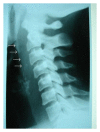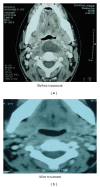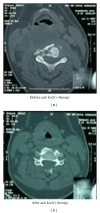Retropharyngeal abscess in adults: five case reports and review of the literature
- PMID: 22125422
- PMCID: PMC3201680
- DOI: 10.1100/2011/915163
Retropharyngeal abscess in adults: five case reports and review of the literature
Abstract
Retropharyngeal abscesses are rare in adults. They occur mostly in immunocompromised patients or as a foreign body complication. We report 5 cases of retropharyngeal abscess collected in the ENT Department of CHU Mohammed VI of Marrakech, during a two-year period (December 2008 to December 2009). Local trauma by foreign body ingestion was the aetiology in four patients. The presenting symptoms, for all patients, were fever, odynophagia, torticollis, and trismus, and the clinical examination showed bulging of the posterior wall of the oropharynx. The radiography of cervical spine showed prevertebral thickening in all cases, this thickening was associated with an aspect of vertebral lysis of the fourth cervical vertebra in one case. A CT scan was performed in all our cases and showed features of retropharyngeal abscess which was associated, in one case, with spondylodiscitis. The biological assessment found one case of diabetes. The intradermal reaction to the tuberculin was clearly positive in one case. Endobuccal abscess puncture was practiced in 4 cases; only one organism was identified by culture: Staphylococcus aureus treatment was based on triple intravenous antibiotics and anti-Koch's therapy (in one case), and the surgical drainage under general anesthesia was also performed in the case of the diabetes patient which required also the correction of hyperglycemia in intensive care unit. The outcome was good in all our patients. The diagnosis of retropharyngeal abscess can be difficult and one must seek a comorbidity; a tuberculosis aetiology must be considered in countries with a high prevalence. The management of these cases is based on antibiotics and surgical drainage.
Keywords: adults; and surgical drainage; antibiotics; retropharyngeal abscess; tuberculosis.
Figures







References
-
- Acevedo JL, Shah RK. Retropharyngeal Abscess. eMedicine Specialties, Pediatrics: Surgery, Otolaryngology, 2009.
-
- Lafitte F, Martin-Duverneuil N, Brunet E, et al. Rhinopharynx et espaces profonds de la face : anatomie et applications a la pathologie. Journal of Neuroradiology. 1997;24(2):98–107. - PubMed
Publication types
MeSH terms
LinkOut - more resources
Full Text Sources
Research Materials
Miscellaneous

